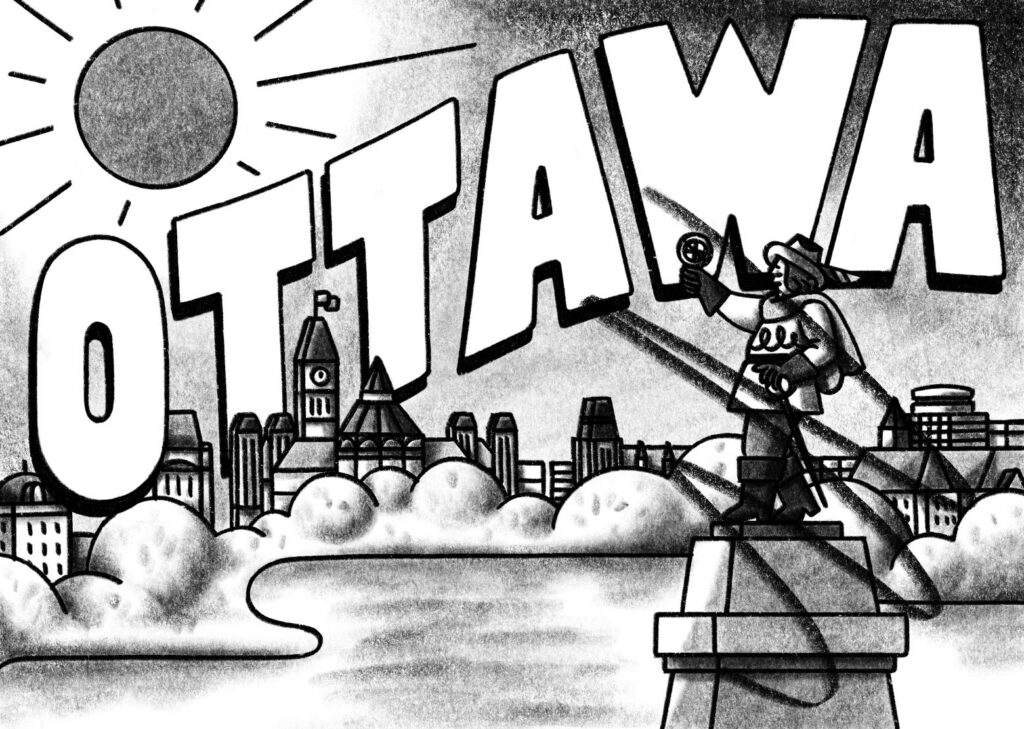In a recent interview on The Hub, the former Canadian Heritage minister James Moore recalled how, during the 2008 federal election, a sleeper issue was lurking in cultural policy. It flared up after the Conservative government reallocated $45 million in funding, triggering consequences that he described as “tectonic” and “searing,” particularly in Quebec. “It’s arguable,” he said ruefully, “we lost our opportunity to win a majority government in 2008 over arts and culture.”
Moore remembers keeping “lids on pots” in his early days at Heritage, but he proved to be one of the department’s most engaged ministers, holding the post for five years. And as prime minister, Stephen Harper keenly supported at least one culture file, national capital commemorations, championing eight such projects between 2008 and 2015. Of these, six were substantially completed during his time in office — a tour de force of “deliverology” that left a distinguished legacy in the capital region.
Government processes changed during this time, as well. In 2013, the National Capital Act was amended to place the National Capital Commission’s Capital Experience program, including national commemorations, under direct ministerial control inside Canadian Heritage. No longer administered at arm’s length (with decision making now less open and transparent, and without the cover of “ministerial deniability”), commemorations became a more frequent source of controversy.

Greetings from a changing National Capital Region.
Gwendoline Le Cunff
The gravitas of Harper-era commemorations found its paradigm in the patriation of the Kandahar Cenotaph. That “grassroots” memorial, first erected at an Afghanistan airfield by soldiers to honour fallen colleagues, bears individual plaques for “158 Canadian Armed Forces personnel, a Canadian diplomat, a Department of National Defence contractor, a Canadian journalist who was embedded with the Canadian Armed Forces, 42 United States armed forces members and one civilian contractor who were under Canadian command,” as stated on the Afghanistan Memorial Hall website. For many, war commemorations like the Kandahar Cenotaph transcend remembrance to become touchstones of national belonging — a transfiguration that Tonya K. Davidson sets out to challenge in Tours inside the Snow Globe.
A Carleton University sociologist, Davidson contends that “war commemoration orthodoxy” too often suppresses and conceals other histories of belonging for Indigenous peoples, women, and workers of various stripes. Adopting the film scholar John Ramlochand’s image of Ottawa as “one of those snowy paperweights, a sealed, enclosed environment, something plastic, hard and unreal,” she guides readers on six walking tours, which take as axiomatic that successive federal governments have systematically “spatialized” settler colonialism, imperialism, militarism, and misogyny through national commemorations. Snow globes are designed to be shaken, she asserts, as she delivers a solid jolt to Bytown’s (and Canada’s) complacent innocence: “This innocence, in the capital city, takes the form of uncritical celebrations of Confederation, Canadian liberalism and multiculturalism, and the concealment of histories of the colonial violence, slavery, and systemic misogyny at the foundation of the country’s development.”
Harsh truths, yes, but such a blanket indictment also forecloses promising lines of inquiry. As the left-leaning sociologist Raymond Williams once observed, what appears culturally “dominant” incorporates both the “residual” and the “emergent.” In deeper archival research, might Davidson have found these trends knottily intertwined? Has the emergent reconciliation agenda wrought tangible change in the capital’s commemorative landscape? What would decolonization actually look like?
In June 2017, teams of young Indigenous architects conducted a design charette to reimagine the urban character of the capital. They then presented their concepts to a packed gathering of the NCC’s Urbanism Lab. For many of the designers, the charette was their first exposure to Ottawa and neighbouring Gatineau. Frankly critical but with a positive outlook, they infused fresh air into the bell jar by tracing contours of a decolonized capital region. Their observations were uncompromising but not immediately iconoclastic; rather, they understood the landscape as a “palimpsest” of meanings that needed reconfiguration to honour and foreground Indigenous strata.
Where Davidson calls out the “persistent, as-yet-unchallenged presence of a prominent monument to Queen Victoria” and tags a statue of Sir John A. Macdonald as “ripe for toppling,” Sam Mukwa Kloetstra, from Mattagami First Nation in northeastern Ontario, spoke of decolonization as a way of seeing. Explaining his team’s vision — mino-bimaadiziwin, or “the good path”— he said, “This isn’t necessarily us layering over an Indigenous layer but rather celebrating one that already exists within the city.”
Davidson acknowledges that existing layer, but she does so intermittently. Descending from Nepean Point, she identifies Cornelia Hahn Oberlander’s Taiga Garden flanking the National Gallery as a settler-colonial assertion of terra nullius, at one with the Group of Seven’s unpeopled landscapes. Yet passing unnoticed stands the magnificent sculpture The Three Watchmen by the Haida artist Jim Hart, descendant of the master carver Charles Edenshaw. Ditto the Métis artist Christi Belcourt’s stained glass in Parliament’s Centre Block, which commemorates the harrowing legacy of Indian residential schools, commissioned following Stephen Harper’s historic apology in 2008.
Further afield, Davidson might have noticed Pindigen Park on LeBreton Flats, co-designed with Kitigan Zibi and Piwakanagan elders, and Place Abinan, an archeological park across the Ottawa River, where the Algonquin artist Simon Brascoupé’s sculpture marks the unearthing of artifacts up to 7,000 years old. Taking account of such place making and toponymy, along with the many instances that Davidson does mention, has the capital landscape in any meaningful way been “decolonized”?
The postcard scenery that once featured a statue of Samuel de Champlain high on Nepean Point is no more. That clumsy conquistador effigy brandishing an upside-down astrolabe had mischaracterized the self-effacing French geographer, mariner, naturalist, and ethnographer since 1915. As part of an NCC redesign initiated in 2017, following Indigenous and public consultations, the monument was removed from the height of what is now called Kìwekì Point. Selected by a national jury, a team led by Janet Rosenberg & Studio will reposition the artwork with less prominence at ground level.
The ongoing work represents a shift in policies and plans that began with the relocation of an Indigenous scout figure from the base of Champlain’s statue in 1996, a controversy well documented by Davidson. Spurred to change, the NCC’s policy began to nurture “under-represented themes” to counterbalance political and military monuments. Its planners embraced the Algonquin elder William Commanda’s vision for an Indigenous centre on Victoria Island, though the “highest and best use” for derelict lands surrounding the sacred Chaudière Falls was to be not the breathtaking renaturalization fervently advocated by Douglas Cardinal and Gilbert Whiteduck but rather condominiums.
At the Urbanism Lab, the Peguis First Nation designer Sharon Thomas didn’t discard the circuit of Confederation Parkway, though she removed automobiles and adjusted its course to have closer contact with the Ottawa River. Her approach reminded me of National Defence officers who, when discussing a proposed memorial route in 2014, shied away from anything triumphal, preferring instead a contemplative path winding along the river. Unlike Canberra’s striking central axis oriented to Australian military history or Pierre L’Enfant’s imposing National Mall in Washington, Ottawa’s diffuse array of military monuments is understated. Confederation Square, the site of the National War Memorial, serves as the decentred focal point, and its story occupies nearly half of Davidson’s book.
These pages contain her best writing. She admits to being “charmed” by Ottawa’s statues, closely observing their “social lives.” With playful animism that skirts close to object-oriented ontology, she discusses hauntings, angelic presences, and what it means to befriend lonely interpretable objects. In fact, the “tour guide” for each of her chapters is an object: that astrolabe, a bronze Laura Secord, a poppy, mica from the War Memorial, a protest placard, and Confederation Square itself, which she describes as a “phantasm agora” that is “haunted by multiple pasts and aborted futures.”
In her description of Enclave, the community-led memorial to murdered women, Davidson captures ephemeral intensities of commemoration, though she doesn’t explore the capital’s endemic town/crown dichotomy. Tarrying with Nellie McClung and the rest of the Famous Five on Parliament Hill, she frets over their eugenics, social gospel influences, and bourgeois mores, but staunchly refuses to “cancel” achievers whose temerity earned a signal victory for women’s rights. With the hill’s statuary currently in storage during Centre Block renovations, one wonders which cast members would return in season 2 of Davidson’s preferred scenography.
As the charette’s participants considered how to decolonize the Parliamentary Precinct, the emergent and the residual fused in reimaginings that discomfited some audience members. One objected to losing the Centennial Flame, which one team would ceremonially extinguish with a Hudson’s Bay blanket. Manicured forecourt lawns would host an ongoing festive and deliberative powwow that spills onto the street, diverting traffic with scattered campfires, tents, community, and discussion. The former American embassy at 90 Wellington would be replaced by a medicinal garden or clad with screens carrying Indigenous imagery. Beacon fires on high points up and down the Ottawa Valley would proclaim a repaired relationship, eschewing “permanence” in favour of cycles and flows. “It’s actually really exciting,” the Cree architecture student Kateri Lucier-Laboucan explained, “that we don’t know what that’s going to look like in twenty years because it’s going to have evolved, hopefully, so much into a true nation-to-nation partnership.”
Mark Kristmanson was CEO of the National Capital Commission from 2014 to 2019.


